【Python机器学习实战】决策树和集成学习(二)——决策树的实现
摘要:上一节对决策树的基本原理进行了梳理,本节主要根据其原理做一个逻辑的实现,然后调用sklearn的包实现决策树分类。
这里主要是对分类树的决策进行实现,算法采用ID3,即以信息增益作为划分标准进行。
首先计算数据集的信息熵,代码如下:
1 import math 2 import numpy as np 3 4 5 def calcShannonEnt(data): 6 num = len(data) 7 # 保存每个类别的数目 8 labelCounts = {} 9 # 每一个样本 10 for featVec in data: 11 currentLabel = featVec[-1] 12 if currentLabel not in labelCounts.keys(): 13 labelCounts[currentLabel] = 0 14 labelCounts[currentLabel] += 1 15 # 计算信息增益 16 shannonEnt = 0 17 for key in labelCounts.keys(): 18 prob = float(labelCounts[key] / num) 19 shannonEnt -= prob * math.log(prob) 20 return shannonEnt
然后是依据某个特征的特征值将数据划分开的函数:
def splitData(dataSet, axis, value): """ axis为某一特征维度 value为划分该维度的值 """ retDataSet = [] for featVec in dataSet: if featVec[axis] == value: # 舍弃掉这一维度上对应的值,剩余部分作为新的数据集 reducedFeatVec = featVec[:axis] reducedFeatVec.extend(featVec[axis+1:]) retDataSet.append(reducedFeatVec) return retDataSet
这个函数是依据选取的某个维度的某个值,分割后的数据,比如:
>>data Out[1]: [[1, 1, 'yes'], [1, 1, 'yes'], [1, 0, 'no'], [0, 1, 'no'], [0, 1, 'no']] >>splitData(data, 0, 1) Out[2]: [[1, 'yes'], [1, 'yes'], [0, 'no']] >>splitData(data, 0, 0) Out[3]: [[1, 'no'], [1, 'no']]
接下来就是从数据中选取信息增益最大的特征了,输入是数据集,返回信息增益最大的特征的index,代码如下:
# 选择最好的特征进行数据划分 # 输入dataSet为二维List def chooseBestFeatuerToSplit(dataSet): # 计算样本所包含的特征数目 numFeatures = len(dataSet[0]) - 1 # 信息熵H(Y) baseEntropy = calcShannonEnt(dataSet) # 初始化 bestInfoGain = 0; bestFeature = -1 # 遍历每个特征,计算信息增益 for i in range(numFeatures): # 取出对应特征值,即一列数据 featList = [example[i] for example in dataSet] uniqueVals = np.unique(featList) newEntropy = 0 for value in uniqueVals: subDataSet = splitData(dataSet, i, value) prob = len(subDataSet)/float(dataSet) newEntropy += prob * calcShannonEnt(subDataSet) # 计算信息增益G(Y, X) = H(Y) - sum(H(Y|x)) infoGain = baseEntropy - newEntropy if infoGain > bestInfoGain: bestInfoGain = infoGain bestFeature = i return bestFeature
接下来就是递归上面的代码,构建决策树了,上节提到,递归结束的条件一般是遍历完所有特征属性,或者到某个分支下仅有一个类别了,则得到一个叶子节点。但有时即使我们已经处理了所有的属性,但是在叶子节点时依旧没能将数据完全分开,在这种情况下,通常采用多数表决的方法决定该叶子节点所属类别。
def majorityCnt(classList): classCount = {} for vote in classList: if vote not in classCount.keys(): classCount[vote] = 0 classCount[vote] += 1 # 按统计个数进行倒序排序 sortedClassCount = sorted(classCount.items(), key=lambda item: item[1], reverse=True) return sortedClassCount[0][0]
然后就可以创建一颗决策树了,代码如下:
def creatTree(dataSet, labels): """ labels为特征的标签列表 """ classList = [example[-1] for example in dataSet] # 如果data中的都为同一种类别,则停止,且返回该类别 if classList.count(classList[0]) == len(classList): return classList[0] # 如果数据集中仅剩类别这一列了,即特征使用完,仍没有分开,则投票 if len(dataSet[0]) == 1: return majorityCnt(classList) bestFeat = chooseBestFeatuerToSplit(dataSet) bestFeatLabel = labels[bestFeat] # 初始化树,用于存储树的结构,是很多字典的嵌套结构 myTree = {bestFeatLabel: {}} # 已经用过的特征删去 del (labels[bestFeatLabel]) # 取出最优特征这一列的值 featVals = [example[bestFeat] for example in dataSet] # 特征的取值个数 uniqueVals = np.unique(featVals) # 开始递归分裂 for value in uniqueVals: subLabels = labels[:] myTree[bestFeatLabel][value] = creatTree(splitData(dataSet, bestFeat, value), subLabels) return myTree
这样一颗决策树就构建完成了,使用上面那个小量的数据测试一下:
>>data Out[1]: [[1, 1, 'yes'], [1, 1, 'yes'], [1, 0, 'no'], [0, 1, 'no'], [0, 1, 'no']] >>labels Out[2]: ['no surfacing', 'flippers'] >>creatTree(data, labels) Out[3]: {'no surfacing': {0: 'no', 1: {'flippers': {0: 'no', 1: 'yes'}}}}
接下来要根据所建立的决策树,对新的样本进行分类,同样用到递归的方法:
def classify(inputTree, featLabels, testVec): # 自上而下搜索预测样本所属类别 firstStr = inputTree.key()[0] secondDict = inputTree[firstStr] featIndex = featLabels.index(firstStr) for key in secondDict.keys(): # 按照特征的位置确定搜索方向 if testVec[featIndex] == key: if type(secondDict[key]).__name__ == 'dict': # 若下一级结构还是dict,递归搜索 classLabel = classify(secondDict, featLabels, testVec) else: classLabel = secondDict[key] return classLabel
同时,还有对决策树的可视化,下面直接给出画图的代码
decisionNode = dict(boxstyle='sawtooth', fc="0.8") leafNode = dict(boxstyle='round4', fc="0.8") arrow_args = dict(arrowstyle='<-') def plotNode(nodeTxt, centerPt, parentPt, nodeType): createPlot.ax1.annotate(nodeTxt, xy=parentPt, xycoords='axes fraction', xytext=centerPt, textcoords='axes fraction', va="center", ha="center", bbox=nodeType, arrowprops=arrow_args) def createPlot(inTree): fig = plt.figure(1, facecolor='white') fig.clf() axprops = dict(xticks=[], yticks=[]) createPlot.ax1 = plt.subplot(111, frameon=False) plotTree.totalW = float(getNumLeafs(inTree)) plotTree.totalD = float(getTreeDepth(inTree)) plotTree.xOff = -0.5/plotTree.totalW plotTree.yOff = 1.0 plotTree(inTree, (0.5, 1.0), '') # plotNode('a decision node', (0.5, 0.1), (0.1, 0.5), decisionNode) # plotNode('a leaf node', (0.8, 0.1), (0.3, 0.8), leafNode) plt.show() def getNumLeafs(myTree): numLeafs = 0 firstStr = list(myTree.keys())[0] secondDict = myTree[firstStr] for key in list(secondDict.keys()): if type(secondDict[key]).__name__ == 'dict': numLeafs += getNumLeafs(secondDict[key]) else: numLeafs += 1 return numLeafs def getTreeDepth(myTree): maxDepth = 0 firstStr = list(myTree.keys())[0] secondDict = myTree[firstStr] for key in list(secondDict.keys()): if type(secondDict[key]).__name__ == 'dict': thisDepth = 1 + getTreeDepth(secondDict[key]) else: thisDepth = 1 if thisDepth > maxDepth: maxDepth = thisDepth return maxDepth def retrieveTree(i): listOfTrees = [{'no surfacing': {0: 'no', 1: {'flippers': {0: 'no', 1: 'yes'}}}}, ] return listOfTrees[i] def plotMidText(cntrPt, parentPt, txtString): xMid = (parentPt[0] - cntrPt[0])/2.0 + cntrPt[0] yMid = (parentPt[1] - cntrPt[1])/2.0 + cntrPt[1] createPlot.ax1.text(xMid, yMid, txtString) def plotTree(myTree, parentPt, nodeTxt): numLeafs = getNumLeafs(myTree) depth = getTreeDepth(myTree) firstStr = list(myTree.keys())[0] cntrPt = (plotTree.xOff + (1.0 + float(numLeafs))/2.0/plotTree.totalW, plotTree.yOff) plotMidText(cntrPt, parentPt, nodeTxt) plotNode(firstStr, cntrPt, parentPt, decisionNode) secondDict = myTree[firstStr] plotTree.yOff = plotTree.yOff - 1.0/plotTree.totalD for key in list(secondDict.keys()): if type(secondDict[key]).__name__ == 'dict': plotTree(secondDict[key], cntrPt, str(key)) else: plotTree.xOff = plotTree.xOff + 1.0/plotTree.totalW plotNode(secondDict[key], (plotTree.xOff, plotTree.yOff), cntrPt, leafNode) plotMidText((plotTree.xOff, plotTree.yOff), cntrPt, str(key)) plotTree.yOff = plotTree.yOff + 1.0/plotTree.totalD
运行createPlot函数,即可得到决策树的可视化,同样运用上面那个简单的数据集:
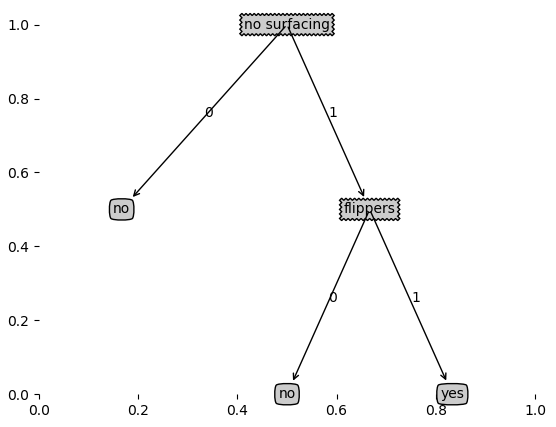
上面就是决策树的一个简单实现过程,下面我们运用“隐形眼镜数据集”对上面的模型进行测试,部分数据如下:
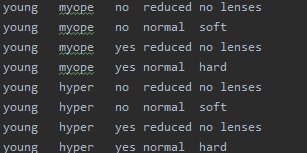
前四列是样本特征,最后一列为样本类别,运用上边的数据集,对模型进行测试:
fr = open('lenses.txt') lenses = [inst.strip().split('\t') for inst in fr.readlines()] lenses_labels = ['age', 'prescript', 'astigmatic', 'tearRate'] lenses_Tree = creatTree(lenses, lenses_labels) createPlot(lenses_Tree)
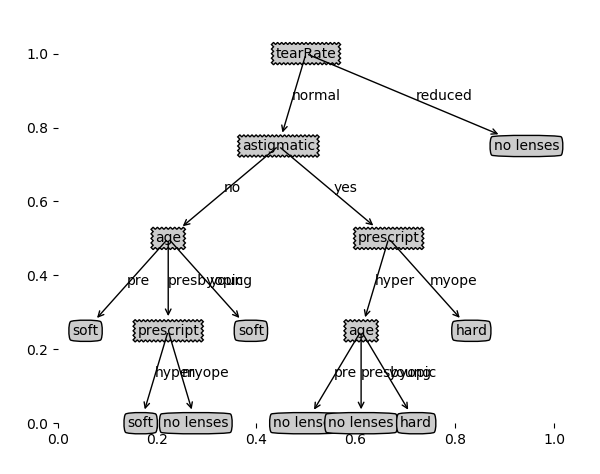
接下来就是对树的剪枝操作,这里主要方法是通过剪枝生成所有可能的树,然后利用测试集,选择最好的树(错误率最低)的树出来,首先建立用预测数据正确率和投票节点的函数:
def testing(myTree, data_test, labels): error = 0.0 for i in range(len(data_test)): classLabel = classify(myTree, labels, data_test[i]) if classLabel != data_test[i][-1]: error += 1 return float(error) # 测试投票节点正确率 def testingMajor(major, data_test): error = 0.0 for i in range(len(data_test)): if major[0] != data_test[i][-1]: error += 1 # print 'major %d' %error return float(error)
然后同样采用递归的方法,产生所有可能的决策树,然后舍弃掉错误率较高的树:
def postPruningTree(inTree, dataSet, test_data, labels): """ :param inTree: 原始树 :param dataSet:数据集 :param test_data:测试数据,用于交叉验证 :param labels:标签集 """ firstStr = list(inTree.keys())[0] secondDict = inTree[firstStr] classList = [example[-1] for example in dataSet] labelIndex = labels.index(firstStr) temp_labels = copy.deepcopy(labels) del (labels[labelIndex]) for key in list(secondDict.keys()): if type(secondDict[key]).__name__ == 'dict': if type(dataSet[0][labelIndex]).__name__ == 'str': subDataSet = splitData(dataSet, labelIndex, key) subDataTest = splitData(test_data, labelIndex, key) if len(subDataTest) > 0: inTree[firstStr][key] = postPruningTree(secondDict[key], subDataSet, subDataTest, copy.deepcopy(labels)) if testing(inTree, test_data, temp_labels) < testingMajor(majorityCnt(classList), temp_labels): return inTree return majorityCnt(classList)
至此,一个简单的ID3决策树已经实现完成了,仅作为算法的理解过程,这里没有考虑连续型数据的处理问题,以及算法中很多不合理的地方。下面就使用python自带的sklearn进行决策树的建立,同时使用另一个比较著名的数据集——“红酒数据集”(数据集链接放在末尾)对建模过程进行了解。
首先导入决策树所需的包:
# 导入决策树包 from sklearn.tree import DecisionTreeClassifier # 画图工具包 import matplotlib.pyplot as plt import seaborn as sns sns.set(color_codes=True) # 导入数据处理的包 from sklearn.model_selection import train_test_split # 模型评估 from sklearn import metrics from sklearn.metrics import accuracy_score, f1_score, recall_score, precision_score import missingno as msno_plot
然后是读取数据,并用describe函数对数据做一个初步的查看:
# 读取红酒数据 wine_df =pd.read_csv('/winequality-red.csv', sep=';') # 查看数据, 数据有11个特征,类别为quality wine_df.describe().transpose().round(2)
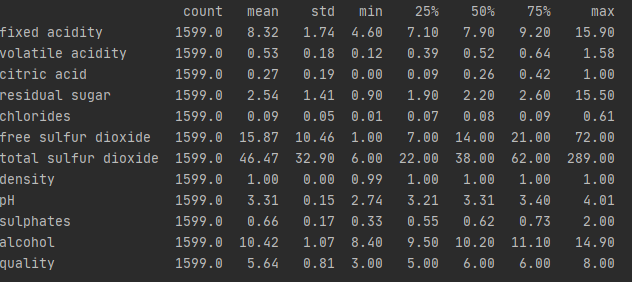
从统计样本count一列来看数据无缺失值,为更直观显示,画出缺失值直方图,如下:
plt.title('Non-missing values by columns') msno_plot.bar(wine_df)
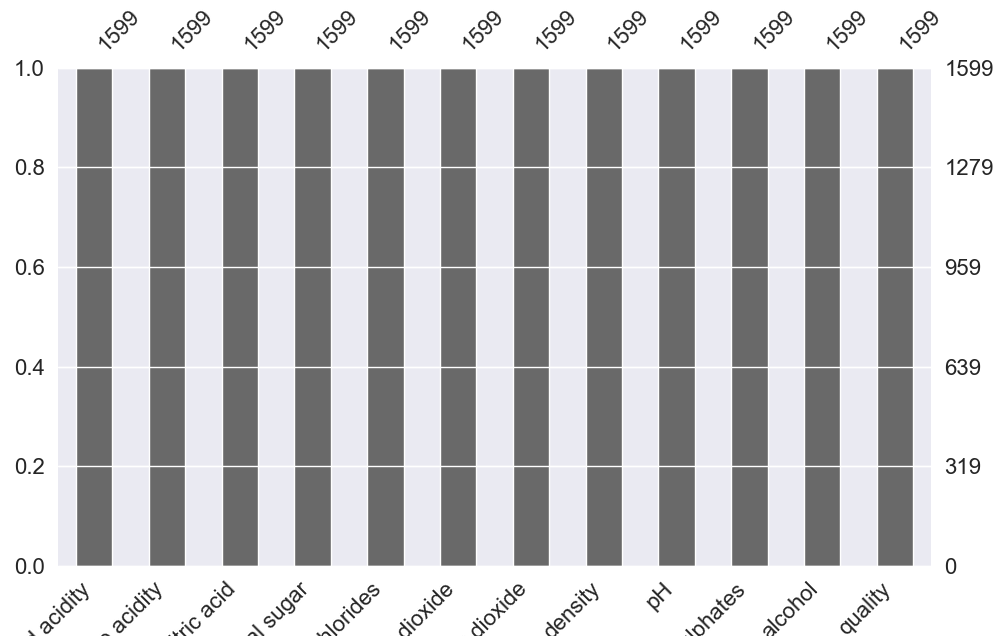
接下来就是异常值的检查,通过每一列数据的箱型图来查看是否存在偏离较远的异常值:
# 通过箱型图查看每一列的箱型图 plt.figure() pos = 1 for i in wine_df.columns: plt.subplot(3, 4, pos) sns.boxplot(wine_df[i]) pos += 1
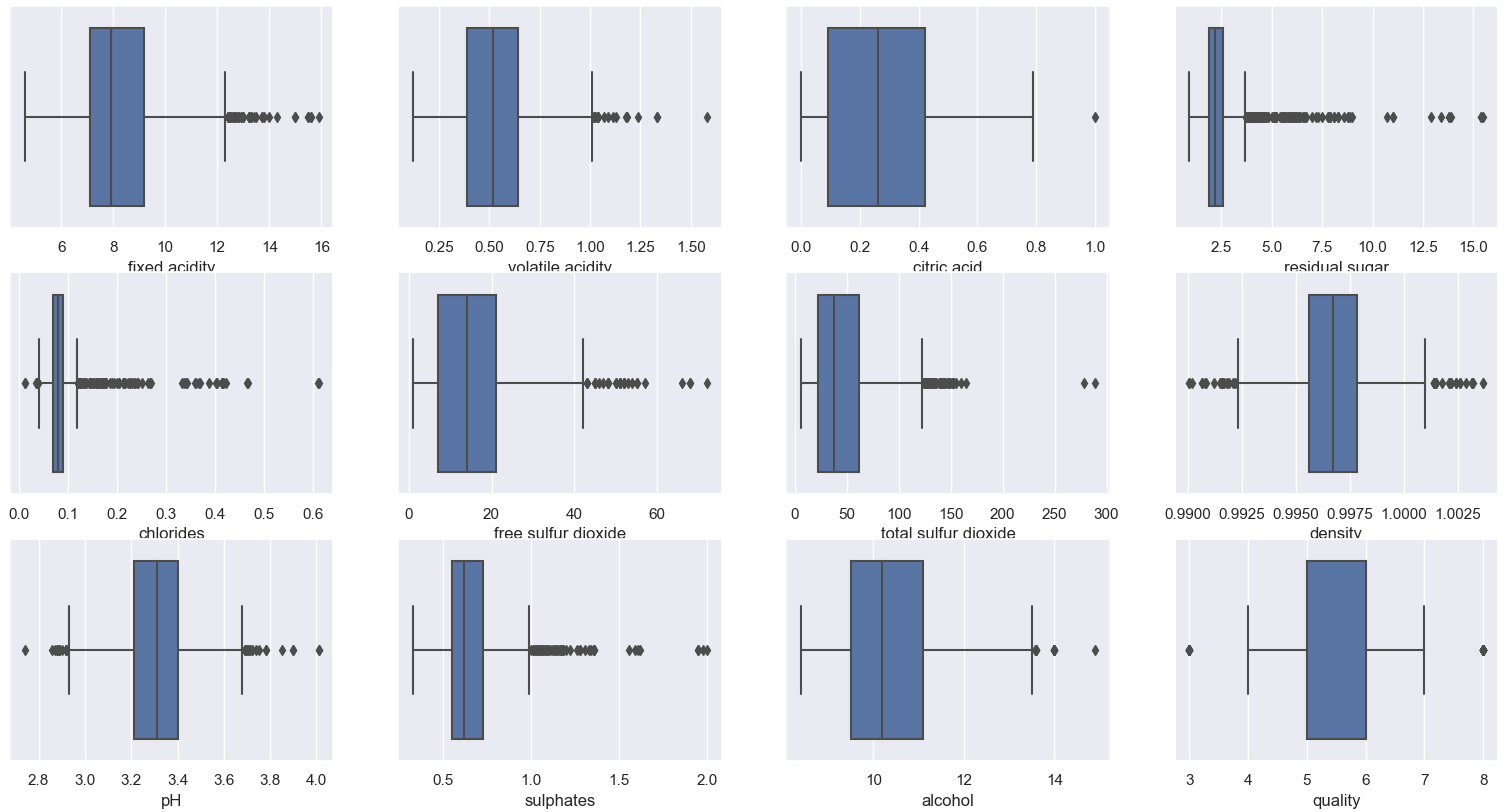
接下来处理异常值,在案例中采用样本的四分之一分位数、四分之三中位数组成的IQR四分位数间的范围来对偏离较远的点进行修正,代码如下:
# 处理缺失值 columns_name = list(wine_df.columns) for name in columns_name: q1, q2, q3 = wine_df[name].quantile([0.25, 0.5, 0.75]) IQR = q3 - q1 lower_cap = q1 - 1.5*IQR upper_cap = q3 + 1.5*IQR wine_df[name] = wine_df[name].apply(lambda x: upper_cap if x > upper_cap else (lower_cap if (x<lower_cap) else x))
然后看下数据两两之间的相关性,sns.pairplot()是展现凉凉之间的线性、非线性和相关等关系。http://seaborn.pydata.org/generated/seaborn.pairplot.html
sns.pairplot(wine_df)

进一步查看两个变量相关性和关系,注意:在决策树中不需要删除高度相关的特征,因为节点只使用一个独立变量被划分为子节点,因此,即使两个变量高度相关,产生最高信息增益的变量也会用于分析。查看变量之间的相关性代码如下:
plt.figure(figsize=(10, 8)) sns.heatmap(wine_df.corr(), annot=True, linewidths=.5, center=0, cbar=False, cmap='YlGnBu')
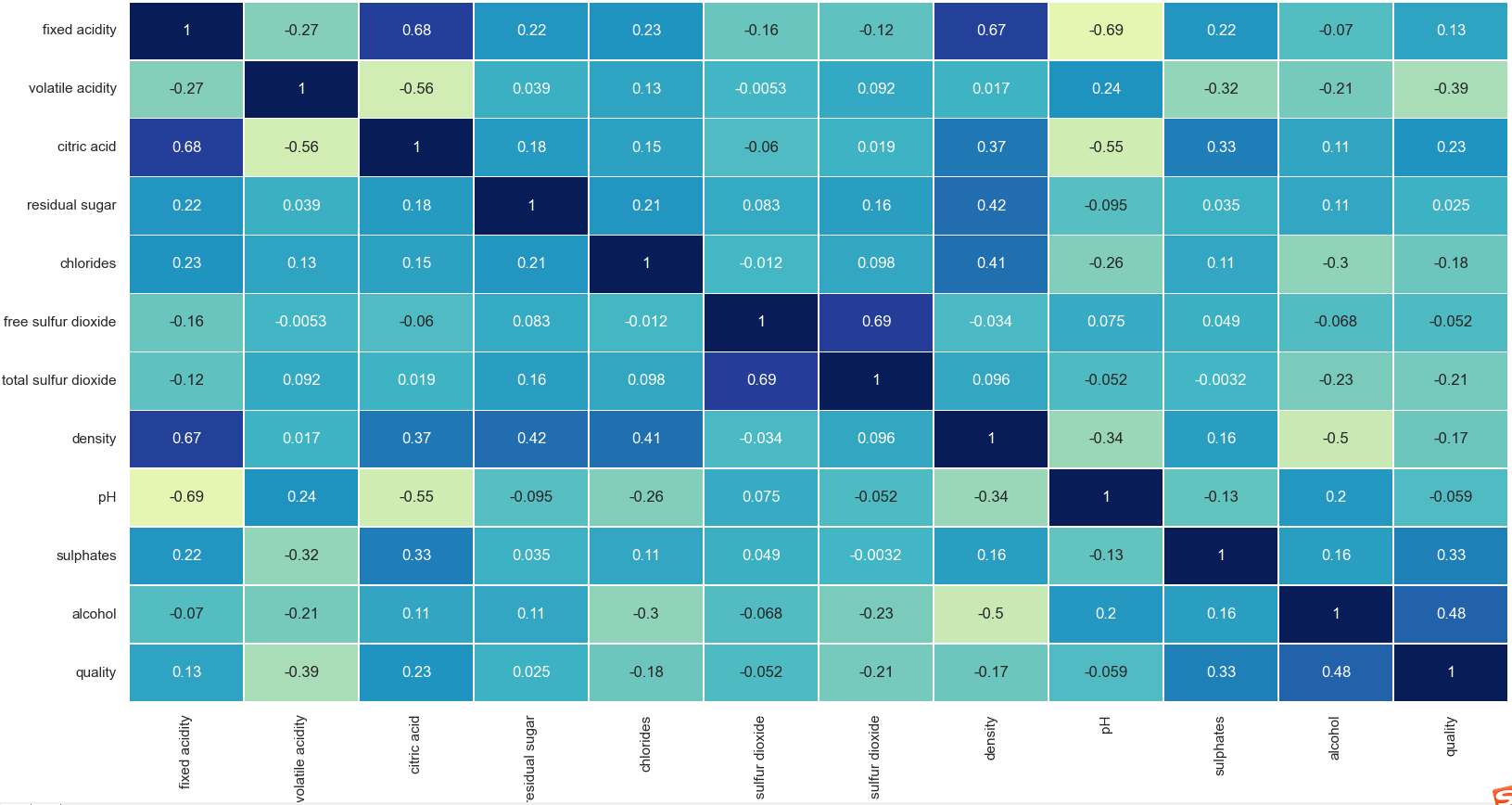
同时,分类问题对于类别的分布情况比较敏感,因此需要查看quality中各个类别的分布情况:
plt.figure(figsize=(10, 8)) sns.countplot(wine_df['quality'])

注意到这里类别中存在3.5连续型数值,要对其进行特殊处理,这里直接删去这一部分样本即可,因为样本量较少,可以看到类别分布相对不是很平衡,因此需要将类别平衡,通过将类别“quality”属性的值组合产生(或者其他的方法):
wine_df = wine_df[wine_df['quality'] != 3.5] wine_df = wine_df[wine_df['quality'] != 7.5] wine_df['quality'] = wine_df['quality'].replace(8, 7) wine_df['quality'] = wine_df['quality'].replace(3, 5) wine_df['quality'] = wine_df['quality'].replace(4, 5) wine_df['quality'].value_counts(normalize=True)
接下来就是将数据分为训练集和测试两部分,测试集是为了检查模型的正确性和准确性,看是否欠拟合或者过拟合:
X_train, X_test, Y_train, Y_test = train_test_split(wine_df.drop(['quality'], axis=1), wine_df['quality'], test_size=0.3, random_state=22) print(X_train.shape, X_test.shape)
Output:(1119, 11) (480, 11)
然后就是确定一个模型,模型及参数详解如下,具体参数解释可参考:https://www.cnblogs.com/hgz-dm/p/10886368.html
model = DecisionTreeClassifier(criterion='gini', random_state=100, max_depth=3, min_samples_leaf=5) """ criterion:度量函数,包括gini、entropy等 class_weight:样本权重,默认为None,也可通过字典形式制定样本权重,如:假设样本中存在4个类别,可以按照 [{0: 1, 1: 1}, {0: 1, 1: 5}, {0: 1, 1: 1}, {0: 1, 1: 1}] 这样的输入形式设置4个类的权重分别为1、5、1、1,而不是 [{1:1}, {2:5}, {3:1}, {4:1}]的形式。 该参数还可以设置为‘balance’,此时系统会按照输入的样本数据自动的计算每个类的权重,计算公式为:n_samples/( n_classes*np.bincount(y)), 其中n_samples表示输入样本总数,n_classes表示输入样本中类别总数,np.bincount(y) 表示计算属于每个类的样本个数,可以看到, 属于某个类的样本个数越多时,该类的权重越小。若用户单独指定了每个样本的权重,且也设置了class_weight参数,则系统会将该样本单独指定 的权重乘以class_weight指定的其类的权重作为该样本最终的权重。 max_depth: 设置树的最大深度,即剪枝,默认为None,通常会限制最大深度防止过拟合一般为5~20,具体视样本分布来定 splitter: 节点划分策略,默认为best,还可以设置为random,表示最优随机划分,一般用于数据量较大时,较小运算量 min_sample_leaf: 指定的叶子结点最小样本数,默认为1,只有划分后其左右分支上的样本个数不小于该参数指定的值时,才考虑将该结点划分也就是说, 当叶子结点上的样本数小于该参数指定的值时,则该叶子节点及其兄弟节点将被剪枝。在样本数据量较大时,可以考虑增大该值,提前结束树的生长。 random_state: 当splitter设置为random时,可以通过该参数设计随机种子数 min_sample_split: 对一个内部节点划分时,要求该结点上的最小样本数,默认为2 max_features: 划分节点时,所允许搜索的最大的属性个数,默认为None,auto表示最多搜索sqrt(n)个属性,log2表示最多搜索log2(n)个属性,也可以设置整数; min_impurity_decrease :打算划分一个内部结点时,只有当划分后不纯度(可以用criterion参数指定的度量来描述)减少值不小于该参数指定的值,才会对该 结点进行划分,默认值为0。可以通过设置该参数来提前结束树的生长。 min_impurity_split : 打算划分一个内部结点时,只有当该结点上的不纯度不小于该参数指定的值时,才会对该结点进行划分,默认值为1e-7。该参数值0.25 版本之后将取消,由min_impurity_decrease代替。 """
接下来就是利用训练数据对模型进行训练:
model.fit(X_train, Y_train)
然后就是查看模型,并对画出训练出来的决策树(这里卡了很久,网上有很多解决办法,在一台电脑成功显示,但另一台总有问题):

然后查看模型在训练集和测试集上的准确率:
test_labels = model.predict(X_test) train_labels = model.predict(X_train) print('测试集上的准确率为%s'%accuracy_score(Y_test, test_labels)) print('训练集上的准确率为%s'%accuracy_score(Y_train, train_labels)) 测试集上的准确率为0.6101694915254238 训练集上的准确率为0.6014558689717925
查看每个特征对于样本分类的重要性程度:
feat_importance = model.tree_.compute_feature_importances(normalize=False) feat_imp_dict = dict(zip(feature_cols, model.feature_importances_)) feat_imp = pd.DataFrame.from_dict(feat_imp_dict, orient='index') feat_imp.rename(columns={0: 'FeatureImportance'}, inplace=True) feat_imp.sort_values(by=['FeatureImportance'], ascending=False).head() Output: FeatureImportance alcohol 0.507726 sulphates 0.280996 total sulfur dioxide 0.190009 volatile acidity 0.021269 fixed acidity 0.000000
前面建模时有提到一些参数如max_depth、min_samples_leaf等参数决定树的提前终止来防止过拟合,而在实际应用中想要找出最佳的一组参数并不容易(但也不是不可能,可以通过GridSearchCV的方法对模型进行模型),另一种在上一节中提到的后剪枝算法,即确定不同的α值,找出最优的决策树,下面看一下α值的变化与数据数据不纯度的变化关系:
path = model.cost_complexity_pruning_path(X_train, Y_train) ccp_alphas, impurities = path.ccp_alphas, path.impurities fig, ax = plt.figure(figsize=(16, 8)) ax.plot(ccp_alphas[:-1], impurities[:-1], marker='o', drawstyle='steps-post') ax.set_xlabel('effective alpha') ax.set_ylabel('total impurity of leaves')
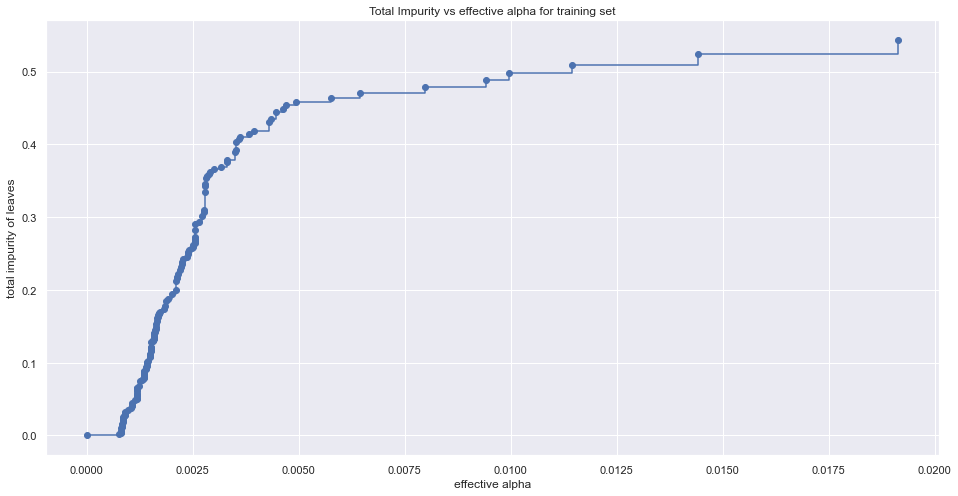
# 根据不同的alpha生成不同的树并保存 clfs = [] for ccp_alpha in ccp_alphas: clf = DecisionTreeClassifier(random_state=0, ccp_alpha=ccp_alpha) clf.fit(X_train, Y_train) clfs.append(clf) # 删去最后一个元素,因为最后只有一个节点 clfs = clfs[:-1] ccp_alphas = ccp_alphas[:-1] # 查看树的总节个点数和树的深度随alpha的变化 node_counts = [clf.tree_.node_count for clf in clfs] depth = [clf.tree_.max_depth for clf in clfs] fig, ax = plt.subplot(2, 1) ax[0].plot(ccp_alphas, node_counts, marker='o', drawstyle='steps-post') ax[0].set_xlabel('alpha') ax[0].set_ylabel('number of nodes') ax[0].set_title("Number of nodes vs alpha") ax[1].plot(ccp_alphas, depth, marker='o', drawstyle='steps-post') ax[1].set_xlabel('alpha') ax[1].set_ylabel('depth of Tree') ax[1].set_title("Depth vs alpha") fig.tight_layout()
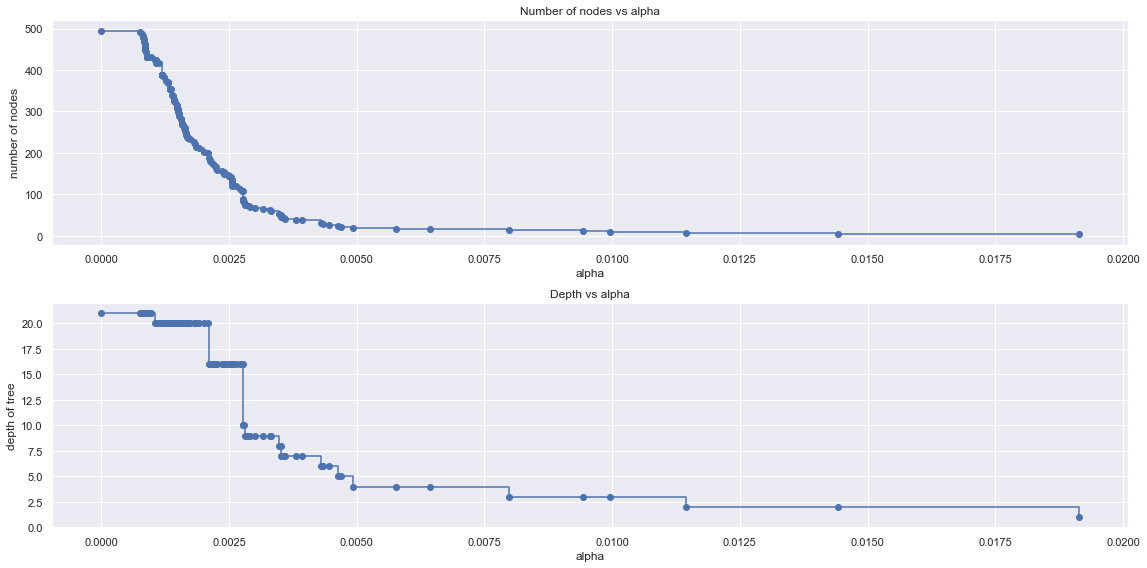
# 查看不同树的训练误差和测试误差变化关系 train_scores = [clf.score(X_train, Y_train) for clf in clfs] test_scores = [clf.score(X_test, Y_test) for clf in clfs] fig, ax = plt.subplots() ax.plot(ccp_alphas, train_scores, marker='o', label='train', drawstyle='steps-post') ax.plot(ccp_alphas, test_scores, marker='o', label='test', drawstyle='steps-post') ax.set_xlabel('alpha') ax.set_ylabel('accuracy') ax.legend() plt.show()
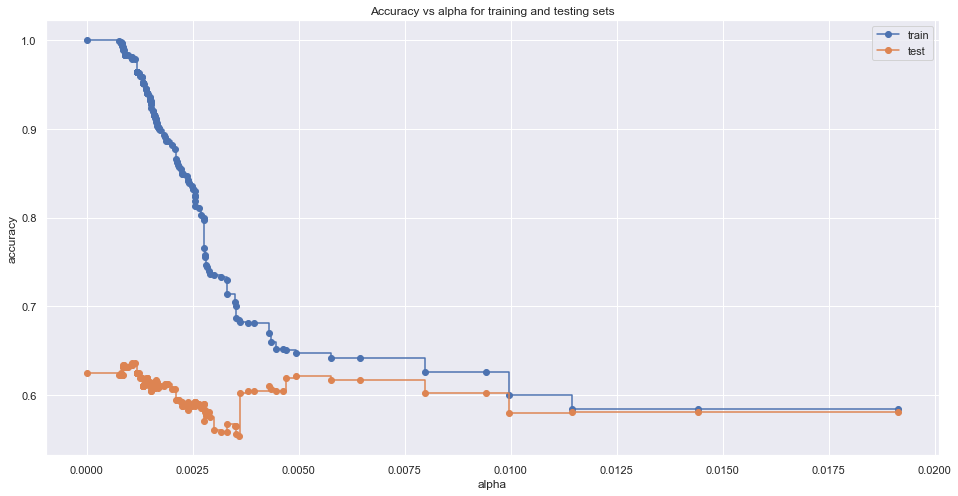
根据上述比较,可以选出最优的α和对应的模型:
i = np.arange(len(ccp_alphas)) ccp = pd.DataFrame({'Depth': pd.Series(depth, index=i), 'Node': pd.Series(node_counts, index=i), 'ccp': pd.Series(ccp_alphas, index=i), 'train_scores': pd.Series(train_scores, index=i), 'test_scores': pd.Series(test_scores, index=i)}) ccp.tail() best = ccp[ccp['test_scores'] == ccp['test_scores'].max()]
参考文献:
官方文档:http://seaborn.pydata.org/generated/seaborn.pairplot.html
博客:https://www.cnblogs.com/panchuangai/p/13445819.html
博客:https://www.cnblogs.com/hgz-dm/p/10886368.html
官方文档:https://scikit-learn.org/stable/auto_examples/tree/plot_cost_complexity_pruning.html
至此,一个简单的决策树案例就算完成了,在实现的过程中也踩了很多坑,有的由于软件和package版本的问题,没有调通,后面再进一步去调,上面建模过程也是其他机器学习的一个较为通用建模流程,不过在数据的处理过程中根据需求有所不同,在此有了一个初步的了解。接下来就是由决策树延伸至集成学习的相关内容了。




【推荐】国内首个AI IDE,深度理解中文开发场景,立即下载体验Trae
【推荐】编程新体验,更懂你的AI,立即体验豆包MarsCode编程助手
【推荐】抖音旗下AI助手豆包,你的智能百科全书,全免费不限次数
【推荐】轻量又高性能的 SSH 工具 IShell:AI 加持,快人一步
· .NET Core 中如何实现缓存的预热?
· 从 HTTP 原因短语缺失研究 HTTP/2 和 HTTP/3 的设计差异
· AI与.NET技术实操系列:向量存储与相似性搜索在 .NET 中的实现
· 基于Microsoft.Extensions.AI核心库实现RAG应用
· Linux系列:如何用heaptrack跟踪.NET程序的非托管内存泄露
· TypeScript + Deepseek 打造卜卦网站:技术与玄学的结合
· 阿里巴巴 QwQ-32B真的超越了 DeepSeek R-1吗?
· 【译】Visual Studio 中新的强大生产力特性
· 10年+ .NET Coder 心语 ── 封装的思维:从隐藏、稳定开始理解其本质意义
· 【设计模式】告别冗长if-else语句:使用策略模式优化代码结构